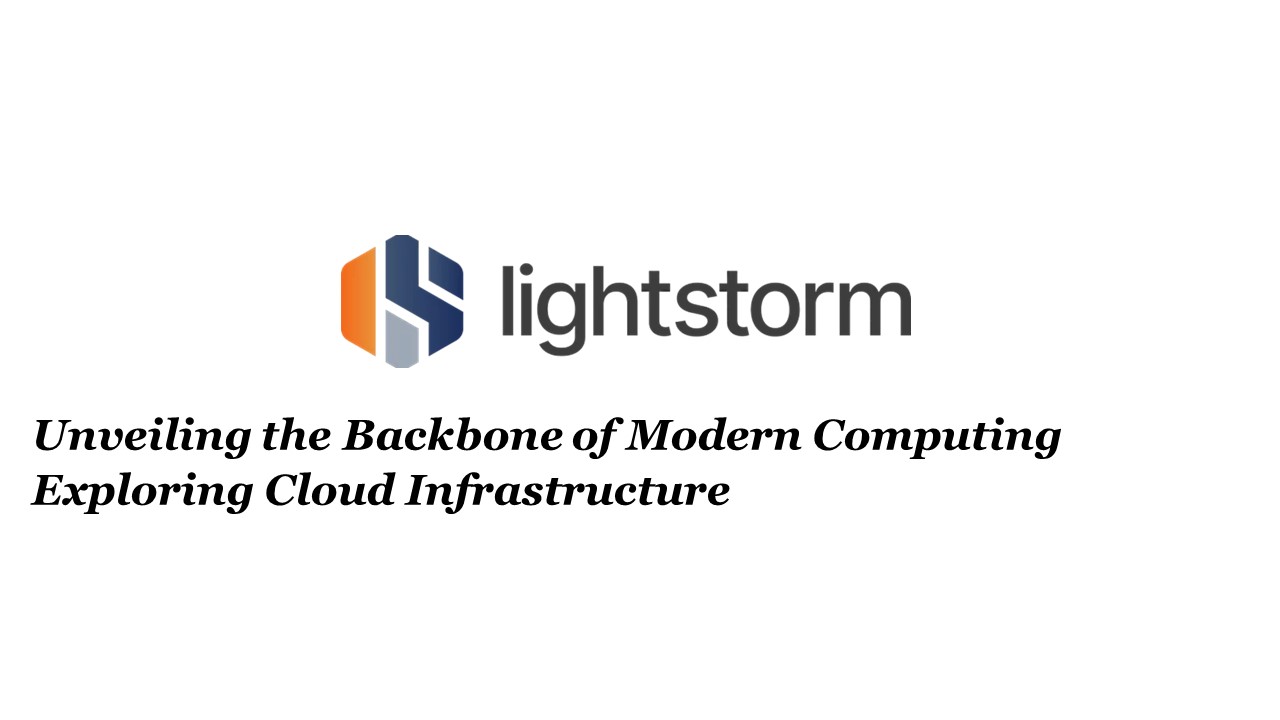Unveiling the Backbone of Modern Computing: Exploring Cloud Infrastructure - PowerPoint PPT Presentation
Title:
Unveiling the Backbone of Modern Computing: Exploring Cloud Infrastructure
Description:
At its core, cloud infrastructure refers to the virtualized, on-demand services that comprise computing resources such as servers, storage, and networking. Unlike traditional on-premises infrastructure, – PowerPoint PPT presentation
Number of Views:0
Title: Unveiling the Backbone of Modern Computing: Exploring Cloud Infrastructure
1
Unveiling the Backbone of Modern Computing
Exploring Cloud Infrastructure
2
In the ever-evolving landscape of digital
technology, one term that resonates profoundly is
"cloud infrastructure." It serves as the bedrock
of modern computing, reshaping the way businesses
manage their IT resources and paving the way for
unprecedented scalability and flexibility. In
this article, we will delve into the intricacies
of cloud infrastructure, understanding its
significance, benefits, and its transformative
impact on the digital realm. Defining Cloud
Infrastructure At its core, cloud infrastructure
refers to the virtualized, on-demand services
that comprise computing resources such as
servers, storage, and networking. Unlike
traditional on-premises infrastructure, cloud
infrastructure is hosted and managed by
third-party providers, accessible to users over
the internet. This fundamental shift in the
approach to IT resources brings forth a myriad of
advantages.
3
- The Components of Cloud Infrastructure
- Compute Resources Virtual machines and servers
that process and execute applications. - Storage On-demand storage solutions for data,
files, and applications. - Networking Infrastructure that facilitates
communication between different components. - Virtualization The technology that enables the
creation of virtual instances of computing
resources.
4
The Significance of Cloud Infrastructure 1.
Scalability One of the defining features of cloud
infrastructure is its inherent scalability.
Businesses can effortlessly scale up or down
based on demand, ensuring optimal performance
during peak periods while minimizing costs during
periods of reduced activity. This flexibility
empowers organizations to align their resources
with fluctuating needs. 2. Cost Efficiency Cloud
infrastructure follows a pay-as-you-go model,
eliminating the need for substantial upfront
investments in physical hardware. Organizations
only pay for the resources they consume,
promoting cost efficiency and allowing for more
strategic allocation of budgetary resources. 3.
Accessibility and Flexibility Cloud
infrastructure facilitates remote access to
computing resources, allowing users to work from
virtually anywhere with an internet connection.
This accessibility enhances flexibility and
contributes to the rising trend of remote work,
especially in the current global landscape.
5
Navigating the Types of Cloud Infrastructure 1.
Public Cloud Operated by third-party providers
and open to the public, public cloud
infrastructure offers a shared pool of computing
resources. It is a cost-effective option for many
businesses, especially those seeking scalability
and flexibility. 2. Private Cloud Dedicated
solely to one organization, private cloud
infrastructure provides enhanced control and
customization. It is an ideal solution for
businesses with specific security and compliance
requirements. 3. Hybrid Cloud Combining elements
of both public and private clouds, hybrid cloud
infrastructure allows organizations to optimize
their resources. It provides the flexibility to
host sensitive data on a private cloud while
utilizing the scalability of a public cloud for
other applications.
6
The Evolution of Cloud Infrastructure As
technology continues to advance, cloud
infrastructure evolves to meet the demands of the
digital age. Emerging trends such as edge
computing, containerization, and serverless
architecture redefine the landscape, offering new
possibilities and efficiencies. Overcoming
Challenges Security and Compliance While the
benefits of cloud infrastructure are undeniable,
challenges related to security and regulatory
compliance must be addressed. Robust security
measures, encryption protocols, and adherence to
compliance standards are paramount to ensuring a
secure cloud environment. Choosing the Right
Cloud Infrastructure Provider Selecting a cloud
infrastructure provider is a critical decision
for organizations embarking on their cloud
journey. Leaders in the industry, such as Amazon
Web Services (AWS), Microsoft Azure, and Google
Cloud Platform (GCP), offer diverse services.
Evaluating factors such as service offerings,
pricing models, and security measures is
essential for making an informed
choice. Conclusion Empowering the Future of
Computing In conclusion, cloud infrastructure
stands as the backbone of modern computing,
propelling businesses into a new era of
efficiency and innovation. With its scalable
nature, cost efficiency, and transformative
impact, cloud infrastructure is not just a
technological choice but a strategic imperative
for organizations seeking to thrive in the
digital landscape.
7
(No Transcript)































